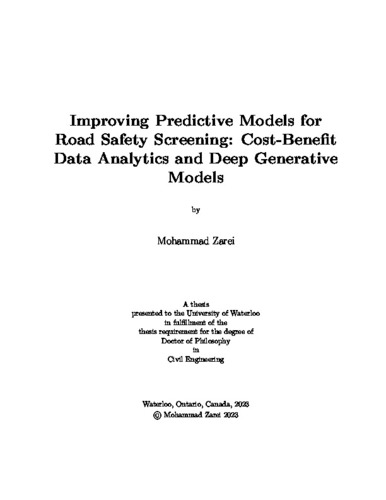| dc.description.abstract | The process of identifying the sites (e.g., road segments, intersections) within a road network that are most in need of detailed safety audits and interventions with the most potential for improvement is known as road safety network screening. This is often accomplished by developing crash predictive models or safety performance functions (i.e. statistical models that relate site characteristics to the number of crashes) and applying the empirical Bayes (EB) method to determine long-term crash risk and rank sites.
Developing SPFs can be costly and requires specialized skills. Jurisdictions must decide whether to use an outdated SPF or incur the costs of redevelopment but there are currently no methods to determine the impact of using an outdated SPF. In addition to being technically demanding and time-consuming, selecting the optimal parametric model and constructing a functional form that best matches the given data can have a considerable impact on the outcome of network screening. Exposure (usually expressed as the Annual Average Daily Traffic volume or AADT) is an important input for SPF develop, but AADT values are typically estimated from sparse measurements and contain error that can impact network screening outcomes and resource allocation for safety improvements. There is currently no way for road authorities to quantify the impact of these errors and the potential benefits from expending resources to make AADT estimates more accurate. Finally, when samples sizes are small, it is frequently not possible to develop statistically reliable SPFs.
This paper-based PhD research is dedicated to improve the crash predictive models and network screening process by addressing the mentioned gaps, in four main objectives. The first objective, fulfilled in Chapter 2, is to develop a benefit-cost analytic solution to determine the near-optimal time to redevelop SPFs considering the expected benefits of SPF redevelopment and the cost of redevelopment. Practitioners can use the proposed method using the data that is either already available in municipalities which have locally developed SPFs or can be easily estimated.
The second objective, addressed in Chapter 3, is to design a method to quantify the monetary benefit of improving AADT accuracy. A simulation based method is proposed and tested over different crash data conditions to evaluate the sensitivity of network screening outcomes to AADT error. The results showed that the potential consequences of using incorrect Average Annual Daily Traffic (AADT) values can vary greatly depending on factors such as error magnitude, sample size, SPF parameters, and sample mean. This means that the impact of AADT inaccuracy on network screening outcomes is not fixed but must be evaluated individually for each jurisdiction which shows the importance of the proposed method to determine how much effort should be put into improving the accuracy of AADT values.
The third objective, realized in Chapters 4 and 5, is to develop a non-parametric Empirical Bayes (EB) estimation method for modeling crash frequency data. To this end, CGAN-EB is formulated based on Conditional Generative Adversarial Networks (CGAN) which unlike parametric approaches, has no need for a pre-specified underlying relationship between dependent and independent variables in the proposed CGAN-EB and is able to model any type of distribution. CGAN-EB is applied to real-world and simulated crash data sets and outperformed the conventional approach (NB-EB) as a benchmark in terms of model fit, predictive performance and network screening outcomes.
Finally, the fourth objective, addressed in Chapter 6, is to investigate the application of deep generative models as a crash data augmentation method to improve SPFs when the size of the available observational dataset is insufficiently large to reliably develop an SPF. A different CGAN model form is used this time to fit the available observed crash data and to generate more (synthetic) crash data to address low sample size issue for SPF development. The method is evaluated using a real-world and simulated crash data. The results showed that data augmentation could improve the results in terms of reducing coefficient standard error and improving the accuracy of SPF predictions but that these improvements were only statistically significant for specific conditions. | en |

